Written by: Barbara Wismer
Most of us are familiar with Henry VIII, that guy with six wives, infamous beheader of his enemies (including a couple wives), whose lust for Anne Boleyn led to the break with the Roman Catholic Church and the start of the Church of England. Arguably the greatest ruler in English history – MOST of English modern history can be traced right back to him. Yes – there is a lot he accomplished, but there is a lot for which he can blamed too. Especially as it relates to Scotland, the Stuart family line, and even the Jacobite rebellions! Here’s why….
- I blame Henry VIII for the small size of the Scottish royal families, so that for successive generations, there was only one heir (often a small child or infant). My theory is that, without Henry, the Scots royalty might have been more fertile, and more choices for rulers would have been available.
- I blame him for the English Civil War – as he was the one who explicitly utilized the “divine right of kings” theory! (He used it to justify his actions in breaking with the Roman Church.)
- I blame him as the root cause for the English crown going to William and Mary, rather than James II, the “rightful” King according to the Jacobites. Yes, 199 years after his death, I blame him for the Jacobite rebellion(s).
What else can we blame him for? I say we blame him for the unification of England and Scotland, so that after Elizabeth died, there was one king for the “united” Kingdom.
- I blame him for that loss of Scottish independence.
 |
|
Drawing by Barb Wismer
|
The first born Tudor son, Arthur, was married to Catherine of Aragon in 1501, and died five months after their marriage. Henry became the heir and inherited the throne upon the death of his father in 1509. After attaining the throne, he married Catherine. (There is some suggestion that this was to prevent having to return Catherine’s dowry, but there were lots of political machinations between Arthur’s death and the death of Henry VII.)
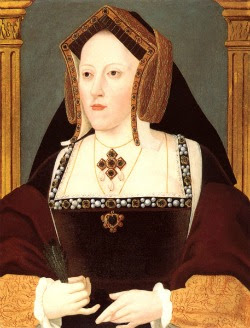 |
|
Catherine of Aragon by Lucas Hornebolte
Licensed under Public Domain via Commons
|
But before Catherine married Henry, her father-in-law (Henry VII) had arranged a marriage for his eldest daughter Margaret to the King of Scotland, James IV in 1503. They had a son, who became James V.
 |
| Margaret Tudor by
Daniël Mijtens Public Domain by Wikipedia Commons
|
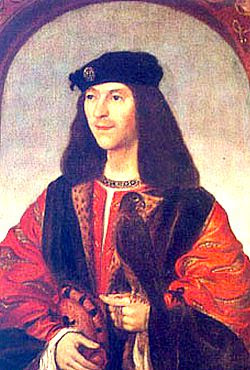 |
|
James IV King of Scotland National Gallery of Scotland. Licensed under Public Domain via Commons
|
At any rate, through Catherine, Henry VIII was aligned with the Spanish, and he and Ferdinand (Catherine’s father) found excellent excuses to make war against the French. So he sailed off to make war and gain glory.
In the meantime, France was urging its ally Scotland to make war on the English while Henry was out of the country. So Henry’s brother-in-law, James IV, (sister Margaret’s husband, remember?) invaded England. However, he was then killed at the Battle of Flodden, thus effectively ending any further expansion of the Scottish royal house. Only one son, James V, remained. Eventually, of course, this had severe consequences. If James IV had lived longer, might he not have had more sons? It could have happened.
But let’s go on. So when Henry VIII decided he needed to marry Anne Boleyn and divorce his wife Catherine, the Pope (for more political reasons, of course) turned down the request. After several years of twists and turns, Henry finally took the advice of Thomas Cromwell, broke from the Church of Rome and made himself the head of his own Church, the Church of England.
 |
| Henry by Hans Holbein the Younger; Anne by unknown Artist Licensed under Public Domain via Commons |
Being, of course, the center of his own world, he then demanded that his nephew, James V of Scotland, do the same thing (i.e., break
with Rome and join Henry’s church.) As you may guess, James V turned down that fabulous opportunity, and so of course there had to be another battle between England and Scotland. The Battle of Solway Moss was again lost by the Scots, and while the king wasn’t on the battlefield, the stress of it all led to his death at age 30 from a fever two weeks after the battle. His daughter Mary was six days old.
So, am I right? Henry VIII proved himself responsible for the death at young ages of two of Scotland’s rightful kings, thus limiting the succession drastically. So can we blame Henry VIII for limiting the Scottish royal lineage? Sure! Maybe with longer-lived Kings, Scotland would have had a more robust royal house, with more and stronger rulers.
 |
|
“Portrait of James V of Scotland (1512 – 1542)” by Corneille de Lyon
Licensed under Public Domain via Commons |
Click here for The Jacobite History Lesson on the Outlander Cast podcast
I’ve got another reason to blame Henry and it is for the brutal and bloody way he enforced his new Church. People who still considered themselves Catholic and practiced Catholicism were hounded, dispossessed, exiled, and most often, killed. There was no choice – you were either with Henry or against him (a very dangerous place to be). From Henry’s time up until the Civil War (only a bit over 100 years later), there were numerous Catholic plots and rebellions. To say that people were passionate about their religion at the time is to understate the situation drastically. Henry enforced submission, and cruelly put down opposition. So, naturally, even those who disagreed mildly moved to hardened enmity. (That’s human nature.)
 |
|
James II by John Riley
Licensed under Public Domain via Commons
|
e Boleyn, Elizabeth was the pampered princess for the first 30 months of her life. While her father had the hopes of having a son with Anne. But once those hopes were dashed, suddenly she became a bastard child. The daughter of an adulteress! And what kind of psychological pain would she have suffered to know that her mother was beheaded! By her father! She had to learn early the tricks of survival, of “going with the flow”, of keeping her head down as she literally hoped to keep it on her neck! Growing up, she experienced periods of becoming accepted at Court (her next stepmother Jane Seymour brought both Mary, Catherine of Aragon’s daughter, and Elizabeth to court, in an attempt to “mother” them.) During the reigns of other “mothers” she was alternately banished and returned to court.
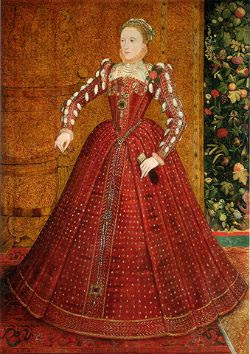 |
|
Elizabeth I by Steven van der Meulen Licensed under Public Domain via Commons
|
And in later life, she was noticeably close to her Carey cousins, the son and daughter of her mother’s sister Mary Boleyn Stafford. Elizabeth always honored her mother and, I suspect, longed for the mother she never had. For a terrific discussion of just this question, see http://beingbess.blogspot.com/2012/08/death-could-not-separate-them-how.html, which I found while researching to find evidence to back my theories.
 |
|
Mary Boleyn
Licensed under Public Domain via Commons
|
In contrast, all her comments about her father were clearly designed to help her politically. She often used the relationship with her father (“I am the lion’s cub”) when her right to rule was doubted because she was female, or when she was being pushed to marry so that she could be “guided” by a man. And so, all through her growing up years, she saw people killed for loving the wrong person, or for failing to get permission to marry, or having drops of royal blood, or simply for just disagreeing with Henry.
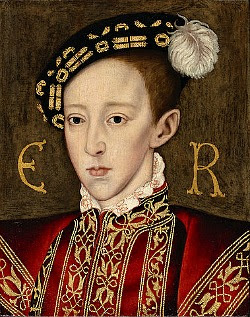 |
|
Portrait of Edward VI of England by Circle of William Scrots
Licensed under Public Domain via Commons
|
Jane was not only the granddaughter of Henry’s sister Mary, she was a staunch Protestant. It was thought that her background, and her religion, could prevent the country from going “back to Catholicism” if Mary Tudor became Queen. And so Lady Jane Dudley (nee Grey) was Queen for 9 days, until Mary Tudor and her followers overthrew the usurpers (which is a whole other story.) And, indeed, Mary (now infamously known as “Bloody Mary”) did try to wrench England back to Catholicism.
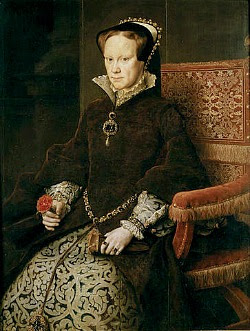 |
|
Maria Tudor1by Antonis Mor
Licensed under Public Domain via Commons
|
After a Protestant rebellion, and jealous of Elizabeth’s popularity, Mary threw her in the Tower for a couple of months, and it had to have been a harrowing five years before Mary died and Elizabeth ascended to the throne in 1558.
With such a childhood, it’s no wonder that poor Elizabeth resolved never to marry, never to have children. It’s believed she made this resolution at quite a young age (8) – and we can certainly see why! Throughout her long forty-four year reign, Elizabeth was often f
orced by politics into performing violent acts, but she always resisted as long as possible from having to behave the way her Father did. She was also terrified to write her will, naming an heir, because then opposing forces could clearly make that heir a rallying point and try to depose her.
And one of those potential heirs was Mary, Queen of Scots. First cousins once removed, according to ancient inheritance rules (and in direct contrast to Henry’s will, which ignored the Scottish connections from his sister Margaret’s marriage) Mary truly was the legitimate heir to Elizabeth. And for years, Mary had declared herself “the LEGITIMATE Queen of England”, since, as a Catholic, she considered Elizabeth a bastard. To Mary Stuart of Scotland, after the death of Mary Tudor, she was the real Queen of England. Talk about your rallying point!
 |
|
Collection: Government Art Collection
|
When Mary Stuart had to flee Scotland and abdicate her throne in favor of her young son, James VI, Elizabeth for her own security had to imprison Mary. It still took Elizabeth almost nineteen years before Mary was finally executed. My point is that, even a very real threat like Mary of Scotland could not make Elizabeth act like her father.
Unfortunately for Scotland, Elizabeth died unmarried and childless. By that time, it was clear to all that the next legitimate heir was James VI, Mary’s son and King of Scotland. So he went south and became James I of England. And thus were England and Scotland unified, the previously-unrealized goal of countless battles – and only realized because one man was an ego-driven, psychopathic tyrant, and his daughter therefore refused to marry and have children. So, yes, let’s blame it all on Henry VIII!
 |
|
James I, VI by John de Critz, c.1606
Licensed under Public Domain via Commons
|







I've read all the same history and I agree with you, but if James I united England and Scotland, why didn't the English treat the Scots like Equals? So much of Outlander is about how badly the English treated the Scots. I know religious differences were the ignition point, but as far as I know James I tried to allow both religions to leave in peace with each other. What advantage did England have to hold Scotland? The same could be said for Ireland, but the Royal family never married any Irish so the throne never crossed with Irish blood.
James II has abondoned his crown when he was escaped in France. Anfd He was'nt a good king. The English has the rigth to defend oneself. The Scots and Catholics were' not above the laws.
Point 1: James II have three Children.
Point 2: The civil war that is Oliver Cromwell it takes the blame.
Point 3: James II was abdicted. And His son James has refused the Crown. He refused to convert. I love Scotland and Scotish but they are responsible what they arrive.
They tried to invade England many time and with James VI Scotland and England was reunited ( Is not the fault of Enfglish) The scots are critized to English to impose a Protestant King but they wanted to do the same but with a catholic King.
Charles Stuart was responsible of Culloden and these consequences. If He was'nt escaped maybe the english would have been most clement with the jacobites rebels.
While you can blame much on Henry VIII, Scotland as a minion of England goes back to the 13th century when Edward I," Longshanks," made himself Lord Paramount of Scotland after arbitrating between two families with claims to the Scottish throne. That title made him fuedal overlord of the country. Edward chose John Balliol to be king of Scotland, then set about to undermine his authority. When the Scots rebelled, he moved English forces in to conquer and control. This constant warfare continued for many years, gaining Edward the nickname "Hammer of the Scots." William Wallace started a freedom movement which eventually led to Robert the Bruce becoming king; his dynasty lasted about 65 years until the Stewart/Stuart families came to power. The Scottish nobility fought for power among themselves and against the authority of the king for many years, making a stable, economically sound country impossible. And, of course, England at the back door was continually interfering in the political dynamics because Catholic Scots aligned themselves with Catholic France against Protestant England.
Trying to state this as delicately as possible. But – what attitude other than arrogance would you expect from an empire-building, warrior nation? Especially when that nation's history was clearly a warlike takeover effort dating back to the days of Robert the Bruce! It only took them 297 years to accomplish this.
I do think everyone is entitled to their own opinion, and of course there were many other persons and activities that led to the unification of England and Scotland. My semi-humorous attempt at "connecting the dots" and pointing back to Henry VIII was not intended as an in-depth look at the history, but simply an interesting take on what happened. And, hopefully, to lead to other thoughts of what might have happened, had Henry not been the way he was.
Oh absolutely! It was a long terrible history, and the internecine warfare between the Scottish nobles left the country wide open to English interference. I agree with you wholeheartedly. I just thought that it might be interesting to look at Henry VIII and see what could be traced to his influence in the long, sad story of Scottish nationhood.
Unquestionably believe that that you stated. Your favourite
reason appeared to be on the internet the simplest factor to have in mind of.
I say to you, I definitely get annoyed whilst folks consider issues that they just do
not understand about. You controlled to hit the nail upon the highest
as well as defined out the whole thing without having side effect , people can take a signal.
Will probably be again to get more. Thanks